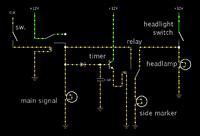BFAL
Newbie level 2

- Joined
- Nov 26, 2012
- Messages
- 2
- Helped
- 0
- Reputation
- 0
- Reaction score
- 0
- Trophy points
- 1,281
- Location
- London UK
- Activity points
- 1,331
I have a Jeep Wrangler and the design of the Jeep means that the side wings (fenders) are wider than the headlamps. I live in the countryside and the width of the vehicle is very difficult to judge by oncoming motorists.
The Jeep is fitted with what US drivers would call side markers in the side of the front fender. These are amber lights which in the UK are used as direction indicator repeaters. I need help to design a circuit that operates the bulb as a sidemarker at night as well as a direction indicator.
The design should acomplish the following:-
In normal daytime operation, the side repeater would flash in time with the direction indicators as it does today
When the side lights (parking lights) are switched on, the side repeater would become a side marker and be turned on constantly
When the direction indicator is switched on with the side lights turned on the side repeater will flash in time with the direction indicator.
I worked out how to do this with relays except that the side repeater would work in the opposite time to the indicator bulb
i.e. When the indicator lamp is on, the side repeater would be off and vice-versa - although I understand this is allowed in North America this is not legal in the UK.
Design wise, when the side lights are off, the indicator could work as normal on a "pass through basis" although the two feeds would need to be separated to stop the main direction indicator bulb turning on when the sidelights are turned on
When the side lights are on, the side marker should be illuminated permanently.
When the direction indicator is turned on then the side marker needs to turn off in time with the indicator ( the earth could be disconnected rather than the live to acheive this if it is easier as the bulb is isolated from the car body) - some form of timed latch would be required so that when the indicator is turned off again the side marker remains switched on
The side repeater bulb is only 6 watts (12volt) so the current switching is not excessive - 2 amps from memory.
I hope somebody can help me out here with a design, I know payment is not appropriate on this forum but I'll happily make a moderate donation to charity for a solution to this for safety reasons. :smile:
The Jeep is fitted with what US drivers would call side markers in the side of the front fender. These are amber lights which in the UK are used as direction indicator repeaters. I need help to design a circuit that operates the bulb as a sidemarker at night as well as a direction indicator.
The design should acomplish the following:-
In normal daytime operation, the side repeater would flash in time with the direction indicators as it does today
When the side lights (parking lights) are switched on, the side repeater would become a side marker and be turned on constantly
When the direction indicator is switched on with the side lights turned on the side repeater will flash in time with the direction indicator.
I worked out how to do this with relays except that the side repeater would work in the opposite time to the indicator bulb
i.e. When the indicator lamp is on, the side repeater would be off and vice-versa - although I understand this is allowed in North America this is not legal in the UK.
Design wise, when the side lights are off, the indicator could work as normal on a "pass through basis" although the two feeds would need to be separated to stop the main direction indicator bulb turning on when the sidelights are turned on
When the side lights are on, the side marker should be illuminated permanently.
When the direction indicator is turned on then the side marker needs to turn off in time with the indicator ( the earth could be disconnected rather than the live to acheive this if it is easier as the bulb is isolated from the car body) - some form of timed latch would be required so that when the indicator is turned off again the side marker remains switched on
The side repeater bulb is only 6 watts (12volt) so the current switching is not excessive - 2 amps from memory.
I hope somebody can help me out here with a design, I know payment is not appropriate on this forum but I'll happily make a moderate donation to charity for a solution to this for safety reasons. :smile:

